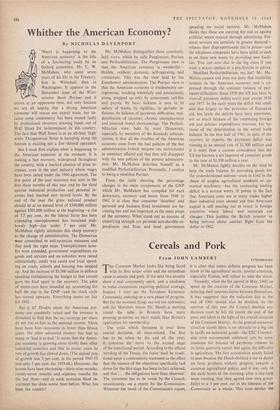Whither the American Economy?
By NICHOLAS DAVENPORT But I must first explain what is happening to the American economy at the moment. It is making a fast recovery, widespread throughout the country, with a marked absence of price in- creases, even in the steel industry where wages have been raised under the 1960 agreement. The low point of the past recession was seen in the first three months of this year and by the third quarter industrial production and personal in- comes had reached new record levels. By the end of the year the gross national product should be at an annual level of $540,000 million against $501,000 million at the beginning—a rise of 7.7 per cent. As the labour force has been expanding unemployment has remained stub- bornly high—just under 7 per cent. Mr. McMahon rightly attributes this sharp recovery to the change of administration. The Democrats were committed to anti-recession measures and they took the right steps. Unemployment bene- fits were extended, government expenditures on goods and services and on subsidies were raised substantially, credit was eased and local spend- ing on roads, schools and housing was stepped up. And the increase of $3,500 million in defence spending (unbalancing the budget to that extent) gave the final spurt to the recovery. The sales of motor-cars have bounded up, accounting for half the rise in the GNP—and the stock cycle has turned upwards. Everything seems set fair for 1962.
But is it? Doubts about the American eco- nomy are constantly raised and the investor is disturbed to find that the net earnings per share do not rise as fast as the national income. There have been four recessions in fewer than fifteen years. No other advanced country has had so many or 'had it so bad.' It seems that the Ameri- can economy is growing more slowly than other industrial countries and that in recent years its rate of growth has slowed down. (The annual rate of growth was 3 per cent. in the period 1947-53 and only 1 per cent. for 1953-60.) Moreover, the booms have been shortening—thirty-nine months, twenty-seven months and eighteen months for the last three—and in each recession fixed in- vestment has done worse than before. What has been the trouble? Mr. McMahon distinguishes three commonly held views, which he calls Panglossian, Puritan and Perfectibilitarian. The Panglossian view is that the American economy is wonderful— flexible, resilient, dynamic, self-operating and cornucopic. This was the view held by the Eisenhower administration. The Puritan view is that the American economy is irredeemably un- regenerate, lurching wastefully and precariously along, propped up only by armaments, tail-fins and payola. Its basic sickness is seen in its satiety of wants, its rigidities, its periodic in- flations, its balance of payments difficulties, mal- distribution of incomes, chronic unemployment and assorted moral shortcomings. The Perfecti- bilitarian view, held by most Democrats, especially by members of the Kennedy adminis- tration, is that all the troubles of the American economy stem from the bad policies of the last administration (which became too restrictionist in monetary affairs) and that they will disappear with the new policies of the present administra- tion. Mr. McMahon describes himself as a modified Perfectibilitarian. Personally, I confess to being a modified Puritan.
From the table showing the percentage changes in the main components of the GNP which Mr. McMahon has compiled for each down-turn, recovery and boom from 1948 to 1961 it is clear that consumer 'durables' and personal and business fixed investment are be- coming less and less important as the main props of the economy. What stand out as sources of underlying strength are personal non-durable ex- penditures and State and local government spending on social services. Mr. McMahon thinks that these are catering for real as against artificial wants created through advertising. Per- sonal services are certainly in greater demand— witness their disproportionate rise in prices—and the telephone companies have been quick to cash in on these new wants by providing new facili- ties. You can now dial in the big cities if you want a prayer spoken or a psychiatrist to advise.
Modified Perfectibilitarian, my hat! Mr. Mc- Mahon cannot and does not deny that instability remains in the American economy and is ex- pressed through the constant balance of pay- ments.difficulties. Since 1950 the US has been in over-all payments deficit every year except 1956 and 1957. In the early years the deficit was small and due largely to the provision of European aid, but lately the deficits have been enormous, not so much because of the continuing foreign aid and defence expenditures overseas, but be- cause of the deterioration in the actual trade balance. In the first half of 1961, in spite of the recovery in exports, the payments deficit was running at an annual rate of $1,500 million and it is more than a curious coincidence that the US has become a net importer of consumer goods to the tune of $1,500 million a year.
Mr. McMahon lightly touches on the need to help the trade balance by providing goods for the underdeveloped nations—even in kind in the shape of surplus agricultural products or un- wanted machinery—but the continuing trading deficit is a serious worry. It points to the fact that American costs are in many trades higher than industrial costs abroad and that American capital is still pouring out to invest in foreign countries where labour and materials are cheaper. This justifies the British investor in being nervous about another flight from the dollar in 1962.










































 Previous page
Previous page